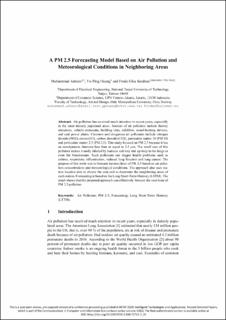| dc.contributor.author | Adrezo, Muhammad | |
| dc.contributor.author | Huang, Yo-Ping | |
| dc.contributor.author | Sandnes, Frode Eika | |
| dc.date.accessioned | 2021-10-18T14:25:23Z | |
| dc.date.available | 2021-10-18T14:25:23Z | |
| dc.date.created | 2021-07-14T15:44:55Z | |
| dc.date.issued | 2021-03-15 | |
| dc.identifier.isbn | 978-3-030-71711-7 | |
| dc.identifier.isbn | 978-3-030-71710-0 | |
| dc.identifier.issn | 1865-0929 | |
| dc.identifier.issn | 1865-0937 | |
| dc.identifier.uri | https://hdl.handle.net/11250/2823738 | |
| dc.description.abstract | Air pollution has received much attention in recent years, especially in the most densely populated areas. Sources of air pollution include factory emissions, vehicle emissions, building sites, wildfires, wood-burning devices, and coal power plants. Common and dangerous air pollutants include nitrogen dioxide (NO2), ozone (O3), carbon dioxide (CO2), particulate matter 10 (PM 10) and particulate matter 2.5 (PM 2.5). This study focused on PM 2.5 because it has an aerodynamic diameter less than or equal to 2.5 μm. The small size of this pollutant makes it easily inhaled by humans and may end up deep in the lungs or even the bloodstream. Such pollutants can trigger health problems such as asthma, respiratory inflammation, reduced lung function and lung cancer. The purpose of this work was to forecast the next hour of PM 2.5 based on air pollution concentrations and meteorological conditions. The approach also uses station location data to cluster the area and to determine the neighboring areas of each station. Forecasting is based on the Long Short-Term Memory (LSTM). The result shows that the proposed approach can effectively forecast the next hour of PM 2.5 pollution. | en_US |
| dc.language.iso | eng | en_US |
| dc.publisher | Springer | en_US |
| dc.relation.ispartof | Proceeding of the 3rd International Conference on Intelligent Technologies and Applications (INTAP) | |
| dc.relation.ispartofseries | Communications in Computer and Information Science;Volume 1382 | |
| dc.subject | Air pollution | en_US |
| dc.subject | Particulate matter | en_US |
| dc.subject | PM 2.5 | en_US |
| dc.subject | Forecastings | en_US |
| dc.subject | Long short-term memory | en_US |
| dc.subject | Long short-term memories | en_US |
| dc.title | A PM 2.5 Forecasting Model Based on Air Pollution and Meteorological Conditions in Neighboring Areas | en_US |
| dc.type | Conference object | en_US |
| dc.description.version | acceptedVersion | en_US |
| dc.rights.holder | © Springer Nature Switzerland AG 2021 | en_US |
| cristin.ispublished | true | |
| cristin.fulltext | original | |
| cristin.fulltext | postprint | |
| cristin.qualitycode | 1 | |
| dc.identifier.doi | https://doi.org/10.1007/978-3-030-71711-7_20 | |
| dc.identifier.cristin | 1921758 | |
| dc.source.volume | 1382 | en_US |
| dc.source.pagenumber | 239-250 | en_US |
